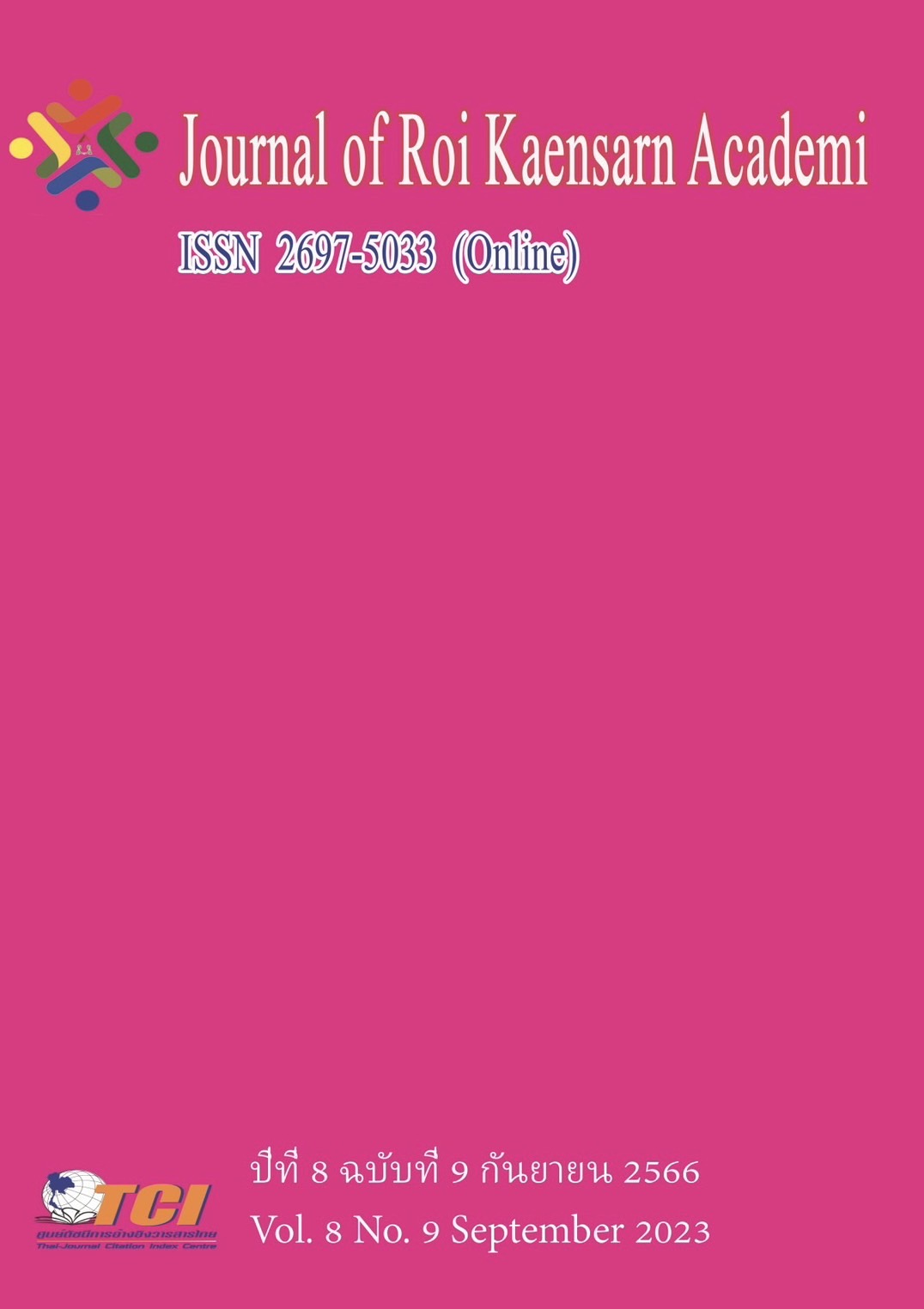การจัดการเรียนรู้โดยใช้ปรากฏการณ์เป็นฐานเพื่อส่งเสริมความฉลาดรู้ด้านวิทยาศาสตร์ของนักเรียนชั้นมัธยมศึกษาปีที่ 5 เรื่อง กรด-เบส
Main Article Content
บทคัดย่อ
การวิจัยในครั้งนี้มีวัตถุประสงค์เพื่อศึกษาแนวทางการจัดการเรียนรู้โดยใช้ปรากฏการณ์เป็นฐานที่ส่งเสริมความฉลาดรู้ด้านวิทยาศาสตร์และศึกษาผลการส่งเสริมความฉลาดรู้ด้านวิทยาศาสตร์ของนักเรียนที่จัดการเรียนรู้โดยใช้ปรากฏการณ์เป็นฐาน ผู้เข้าร่วมวิจัย คือ นักเรียนชั้นมัธยมศึกษาปีที่ 5 จำนวน 37 คน รูปแบบการวิจัยเป็นการวิจัยเชิงปฏิบัติการ จำนวน 3 วงจรปฏิบัติการ เครื่องมือที่ใช้วิจัยได้แก่ แผนการจัดการเรียนรู้ แบบบันทึกสะท้อนผลการจัดการเรียนรู้ แบบทดสอบความฉลาดรู้ด้านวิทยาศาสตร์และใบกิจกรรม วิเคราะห์ข้อมูลโดยการวิเคราะห์เชิงเนื้อหาและตรวจสอบข้อมูลเชิงคุณภาพด้วยเทคนิคสามเส้า แนวทางการจัดการเรียนรู้โดยใช้ปรากฏการณ์เป็นฐานเพื่อส่งเสริมความฉลาดรู้ด้านวิทยาศาสตร์ของนักเรียน มีลักษณะดังนี้ 1) ครูเลือกปรากฏการณ์มานำเสนอให้นักเรียนสังเกตปรากฏการณ์ ซึ่งปรากฏการณ์มีความสำคัญต่อการจัดการเรียนรู้อีกทั้งเป็นตัวจุดเริ่มต้นของกระบวนการเรียนรู้ ในสถานการณ์นั้นๆ 2) ครูให้นักเรียนร่วมกันวิเคราะห์ข้อมูลเพิ่มเติม โดยครูผู้สอนจะให้ข้อมูลปรากฏการณ์เพิ่มเติมเพื่อให้นักเรียนใช้ประกอบการตั้งคำถามหรือกำหนดปัญหา ซึ่งเป็นส่วนสำคัญในกระบวนการเรียนรู้ให้เกิดขึ้นต่อไป 3) นักเรียนได้ลงมือปฏิบัติศึกษาค้นคว้าด้วยกระบวนการที่หลากหลาย เช่น การทำการทดลอง 4) นักเรียนสะท้อนคิดสิ่งที่ได้เรียนรู้จากปรากฏการณ์ที่นำมาร่วมกันศึกษาโดยนักเรียนจะได้สะท้อนความรู้ที่ได้นำมาใช้ในกระบวนการเรียนรู้ และผลการส่งเสริมความฉลาดรู้ด้านวิทยาศาสตร์ที่จัดการเรียนรู้โดยใช้ปรากฏการณ์เป็นฐาน เรื่อง กรดเบส พบว่า นักเรียนมีระดับความฉลาดรู้ด้านวิทยาศาสตร์อยู่ในระดับที่ 5 และมีคะแนนเฉลี่ยสมรรถนะทางวิทยาศาสตร์ในแต่ละสมรรถนะเพิ่มสูงขึ้น
Article Details
เอกสารอ้างอิง
พันธุพฤกษ ดาวัลย์ และสิรินภา กิจเกื้อกูล.(2565). มุมมองของครูวิทยาศาสตรตอการสงเสริมความฉลาดรูดานวิทยาศาสตรดวยการจัดการเรียนรูแบบออนไลน์ Science Teacher’s View on Promoting Scientific Literacy through Online Teaching. วารสารศึกษาศาสตร มหาวิทยาลัยขอนแกน. 45 (2), 18
พิมพลอย ตามตระกูล. (2564). การพัฒนาความฉลาดรู้ด้านวิทยาศาสตร์ เรื่อง กรด-เบส ด้วยการจัดการเรียนรู้ แบบใช้บริบทเป็นฐานร่วมกับการใช้เทคโนโลยี สำหรับนักเรียนชั้นมัธยมศึกษาปีที่ 5.วิทยานิพนธ์ปริญญามหาบัณฑิต. สาขาวิทยาศาสตร์ศึกษา. บัณฑิตวิทยาลัย: มหาวิทยาลัยนเรศวร.
พุทธริธร บูรณสถิตวงศ์. (2562). การพัฒนาสมรรถนะการอธิบายปรากฏการณ์ในเชิงวิทยาศาสตร์และสมรรถนะการแปลความหมายข้อมูลและประจักษ์พยานในเชิงวิทยาศาสตร์ของนักเรียนชั้นมัธยมศึกษาปีที่ 4 ด้วยการจัดการเรียนรู้วิทยาศาสตร์โดยการใช้สื่อโฆษณา เรื่อง ระบบย่อยอาหาร. วารสารศึกษาศาสตร์ มหาวิทยาลัยนเรศวร. 21 (2), 222-223
สถาบันส่งเสริมการสอนวิทยาศาสตร์และเทคโนโลยี. (2560). กรอบโครงสร้างการประเมินผลนักเรียนโครงการ PISA 2015. กรุงเทพมหานคร: สำนักงานคณะกรรมการส่งเสริมสวัสดิการและสวัสดิภาพครูและบุคลากรทางการศึกษา.
อรพรรณ บุตรกตัญญู. (2561). การเรียนรู้โดยใช้ปรากฎการณ์เป็นฐานเพื่อการสร้างแบบองค์ร่วมและการเข้าถึงโลกแห่งความจริงของผู้เรียน. วารสารครุศาสตร์ จุฬาลงกรณ์มหาวิทยาลัย. 46 (2), 348-365
Daehler, K. & Folsom, J. (2016). Making Sense of SCIENCE: Phenomena-Based Learning. Online. Retrieved September 20, 2022, from: http://www.WestEd.org/mss
Kompa, J. S. (2017). Remembering Prof. Howard Barrows: Notes onproblem-based learning and the school of the future. Online. Retrieved September, 10, 2022, from : https://joanakompa.com/tag/phenomenon-based-learning/
Silander,P. (2015). Phenomenon-based learning. Online. Retrieved September 17,2022, fromhttp://www.phenomenaleducation.info/phenomenon-based-learning.html.
Symeonidis, V. & Schwarz, J.F.(2016). Phenomenon-Based Teaching and Learning through the Pedagogical Lenses of Phenomenology: The Recent Curriculum Reform in Finland. Forum OSwiatowe. 28 (2), 31-47

